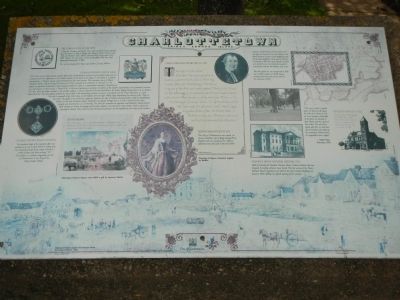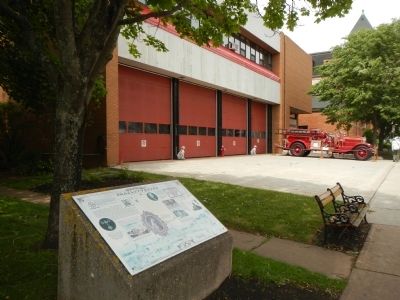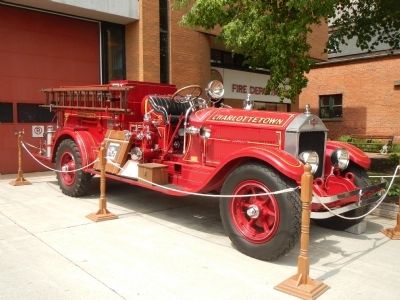Charlottetown in Queens County, Prince Edward Island — The Atlantic Provinces (North America)
Charlottetown
Prince Edward Island
The Capital to be called Charlotte Town is proposed to be built on a point of the harbor of Port Joy, betwixt York and Hillsborough Rivers, as being one of the best, and nearly central Parts of the Island, has the advantage of an immediate and easy Communication with the interior Past by means of three fine Rivers of the Hillsborough, York and Elliot. The Ground designed for the Town and Fortifications is well situated upon a regular Ascent from the Water Side.. a Battery or two, some Distance advanced, will entirely command the Harbour…”
This marker includes several captioned, some of them quite lengthy, illustrations and pictures. The captions are presented below in the following order; left side, top to bottom, center and right side, top to bottom. Click on the image of this marker to enlarge it and view the illustrations/pictures.
“That the Common Seal of the City, made of Silver, having engraved on it the device of Ship, a Plough and Sheaf of Grain, and the words ‘City of Charlotte Town, Prince Edward Island, Incorporated A.D. 1855’ shall be the City Seal. - Law to Establish the City Seal Approved December 7, 1855.
The Seal was designed by “fancy sign printer”, George Milliner.
The City’s Coat of Arms blends symbols drawn from Charlottetown’s rich past and beautiful setting and are centered around her importance as the Island’s capital. At the heart of the design, on the shield, is a stylized representation of Queen’s Square and Charlottetown’s four other squares. The coronation of Queen Charlotte Sophia, wife of George III honours the City’s namesake and underlines its importance as the capital, an important community in the Canadian federation, which is a constitutional monarchy, Charlottetown was, and remains, in many senses, a “Royal City”. as the seat of government and place of residence of the Queen’s representative, the Lieutenant Governor. The crest, above the helmet contains a new heraldic emblem, a coronet composed of the provincial flower, the Lady’s Slipper. Rising above it is an element drawn from the City’s first official symbol, the seal of 1855, a sail representing maritime commerce and industry and the City’s importance as a port. The sail is composed of the City’s arms, and old tradition from the high Middle Ages, dramatizing the concept of the “Ship of the City”. The griffin is one off the two supporters found in the arms of Queen Charlotte’s father, Duke of Mecklenberg-Strelitz. In this case it honours Queen Charlotte’s own family heritage and is, as well, a symbol of the City’s strength and determination as a community. The silver fox represents an important and distinctive Island industry. Both animals are shown, in keeping with heraldic tradition, with their fierce spirit, and ready to protect the corporation’s interests. They stand on land showing the province’s red soil separated by the waters of the harbour.
The centre square, was set aside for institutional use like government, court, market and church. Four squares, one in each quarter of the city added much quality to the plan of the town.
Painting of Queen Square circa 1880’s a gift by Spenser Macky.
The handsome badge of the mayoralty office was presented to the city in April 1919. It is sterling silver and composed of maple leaves neatly enclosed in a wreath of leaves and links enclosing “C’s”. The pendent is a sunburst surrounding the seal of Charlottetown. It was designed by Mayor Dudley Wright.
Painting of Queen Square and Province House by George Hubbard - 1849
The City of Charlottetown was named for Queen Charlotte, wife of King George III of England and was incorporated in 1855. Its settlement roots date back to the mid 1700’s
Painting of Queen Charlotte Sophia by Kadlec.
Surveyor Charles Morris of Nova Scotia with the input of Lieutenant-Governor Patterson and Island Surveyor General, George Wright surveyed the site and established a town center of 500 lots, a Common of 500 Acres and a Royalty of 6,401 acres divided into 12 acre fields that would be used for farm land for residents of the town.
This little capital was incorporated in 1855 and in 1996 counted over 32,531 citizens covering almost the same area set aside by the visionaries of 1767.
“ The way in which a capital’s spaces are laid out will inspire the pride of its citizens. It will act as an expression of their faith in the future, the diversity of their cultures and the nature of their values. The soul of the capital, after all, is no more than the soul of those who make up the community. Without them, it is impossible to have a capital.” - Serge Viau, February, 1994
City Hall, designed by Chappell and Phillips, offers a (?) architectural landmark in the center of the city. The first city council meeting to be held their was on December (?), 1888.
Built by Islanders for Islanders, Province House National Historic Site was designed by leading architect, Isaac Smith. The first session of the Prince Edward Island Legislature to be held in the new Colonial Building was January 1847, marking the official opening of the structure.
Erected by City of Charlottetown.
Topics. This historical marker is listed in this topic list: Settlements & Settlers. A significant historical month for this entry is January 1847.
Location. 46° 14.092′ N, 63° 7.798′ W. Marker is in Charlottetown, Prince Edward Island, in Queens County. Marker is on Kent Street near Queen Street, on the left when traveling east. Touch for map. Marker is at or near this postal address: 83 Kent Street, Charlottetown PE C1A 1M9, Canada. Touch for directions.
Other nearby markers. At least 8 other markers are within walking distance of this marker. Big Donald (within shouting distance of this marker); Canadian National Hotels (within shouting distance of this marker); Charlottetown City Hall (within shouting distance of this marker); Apothecaries Hall (about 150 meters away, measured in a direct line); A Dutiful Citizen / Un citoyen consciencieux (about 150 meters away); Confederation Centre of the Arts (about 180 meters away); All Souls’ Chapel (about 240 meters away); Prince Edward Island War Memorial (approx. 0.3 kilometers away). Touch for a list and map of all markers in Charlottetown.
More about this marker. This marker is located to the left of the fire station.
Also see . . . Charlottetown - Wikipedia. Charlottetown ... is both the largest city on and the provincial capital of Prince Edward Island, and the county seat of Queens County. Named after Charlotte of Mecklenburg-Strelitz, queen consort of the United Kingdom, Charlottetown was first incorporated as a town in 1855 and designated as a city in 1885. It was most famously the site of the Charlottetown Conference in 1864, the first gathering of Canadian and Maritime statesmen to debate the proposed Maritime Union and the more persuasive British North American Union, now known as Canadian Confederation. (Submitted on January 11, 2015, by Barry Swackhamer of Brentwood, California.)
Credits. This page was last revised on October 18, 2022. It was originally submitted on January 11, 2015, by Barry Swackhamer of Brentwood, California. This page has been viewed 429 times since then and 16 times this year. Last updated on October 14, 2022, by Carl Gordon Moore Jr. of North East, Maryland. Photos: 1, 2, 3. submitted on January 11, 2015, by Barry Swackhamer of Brentwood, California. • Andrew Ruppenstein was the editor who published this page.


